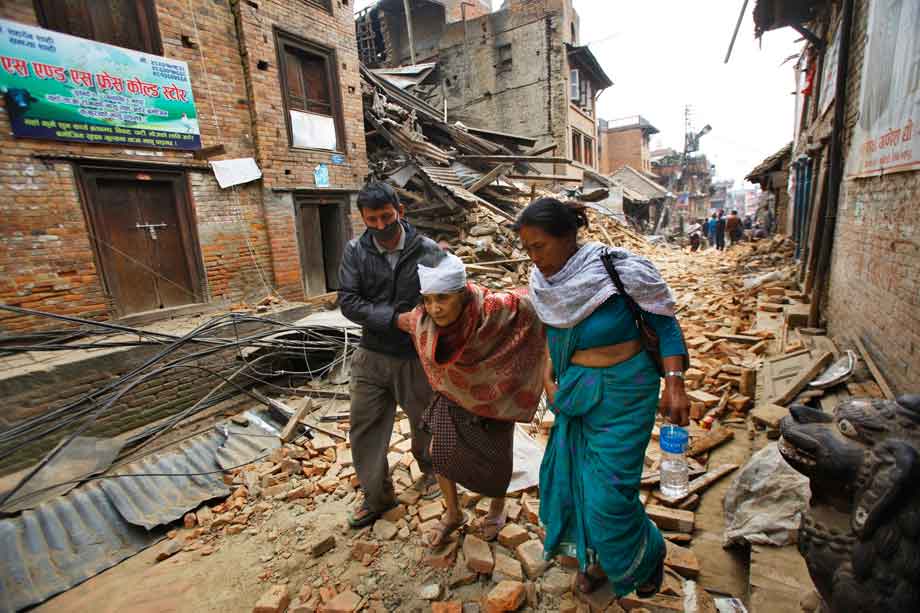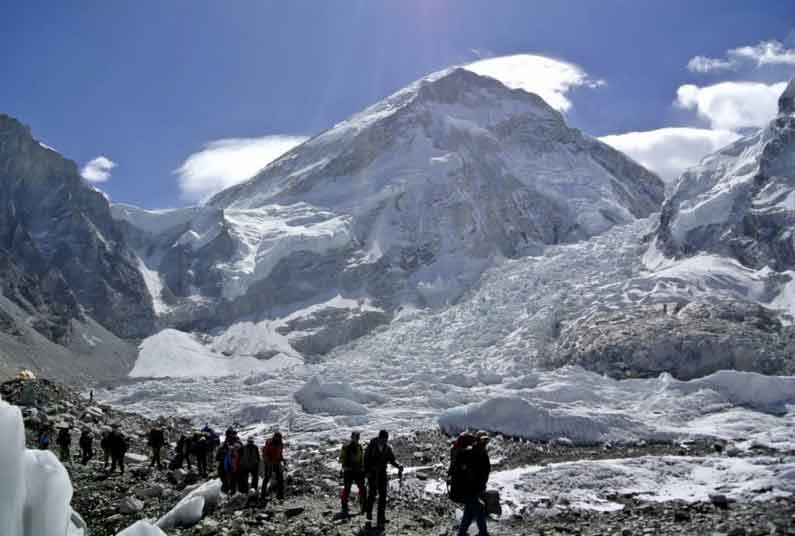Death Toll In Nepal Earthquake Mounting Every Hour
By Countercurrents.org
26 April, 2015
Countercurrents.org

Death toll in the Nepal earthquake is mounting every hour. It may cross 2,200, the figure found only a few hours ago, the moment this Countercurrents report reaches readers. A state of emergency has been declared in the Himalayan country as it faces an unprecedented human crisis with widespread damage of its major infrastructure that reduces capacity to face the human crisis-situation. An emergency Nepal cabinet meeting has announced 29 districts in the country as crisis zones. A primary UN assessment finds almost 7 million people have been affected.
The quake caused damage to properties worth over billions of dollars. After the Saturday’s 7.8 magnitude earthquake at least 45 after-shocks jolted the small country yesterday and today. At least seven after-shocks were felt Sunday. A 5.3-magnitude quake hit Tibet after Nepal earthquakes.
Countries and relief agencies are rushing with relief material and rescue equipments with India being the “first responder” country. But damaged roads and severed communications are slowing down rescue and relief efforts.
Availability of electricity and safe drinking water is a major problem. Windy, cold, wet weather has increased human suffering. People are gathered in their thousands in open spaces and are scared as there have been several aftershocks. Roads have been damaged or blocked by landslides and communication lines are down preventing to get accurate information. Cut off electricity has been making charging mobile phones difficult. There is an urgent need for emergency shelters, food and clean drinking water, warm clothing blankets and hygiene kits
According to the US Geological Survey report the following after-shocks, shown in magnitude and depth, were felt today:
4.5 (magnitude) 21km (depth) NE of Nagarkot,
4.6 16km E of Panaoti,
4.7 25km S of Kodari,
5.0 29km SSW of Kodari,
6.7 17km S of Kodari,
4.4 30km NE of Bharatpur,
4.6 24km ESE of Lamjung.
At lest one of these after-shocks was of 6.7 magnitude. It is devastating. The U.S. Geological Survey says the aftershock registered at a very shallow depth of 10 kilometers (6 miles) and that damage was very likely within a radius of 50 kilometers (31 miles). The ground rumbled as the tremor sent people yelling and running for open ground.
Nepal’s Home Ministry’s update on Sunday afternoon said: The death toll: 2263, and injured: 5580 people.
But the number is rising quickly, and it will rise more in the coming days as rescue teams will reach more areas and more damaged structures will be removed. The International Federation of the Red Cross and Red Crescent Societies (IFRC) said it was extremely concerned about the fate of rural villages close to the epicentre of the quake, some 80 kilometres (50 miles) from the capital Kathmandu.
"We do not yet know the scope of the damage, but this could be one of the deadliest and most devastating earthquakes since the 1934 tremor which devastated Nepal and Bihar," said Jagan Chapagain, Asia/Pacific director of the IFRC.
City hospitals remained overwhelmed and tens of thousands of people, fearful of aftershocks bringing down more buildings, spent Saturday night outside.
The UN said emergency supplies were running out, as was space to store corpses.
Most areas were without power and water Sunday. Kathmandu airport reopened briefly before closing again due to the aftershock. Rescuers were continuing to dig through the rubble of concrete, bricks, wood and iron to hunt for survivors.
In one particularly harrowing incident on Sunday, police in Kathmandu's Kalanki neighborhood were trying to save a man who was trapped under a dead person. His family stood nearby crying and praying.
"We are digging the debris around him, cutting through concrete and iron beams. We will be able to pull him out but his body under his waist is totally crushed. He is still alive and crying for help. We are going to save him," said police officer Suresh Rai.
The Everest climbers

Injured climbers at Mount Everest, where an avalanche struck following the quake, have been flown by helicopter to receive medical treatment.
The international community sending paramedics, doctors, rescue experts, relief material including drinking water, ready-food, blanket, and rescue equipment, dogs, generators, field hospitals, etc. include: India, Sri Lanka, Bangladesh, China, Russia, Pakistan, Spain, Norway, the US, Australia, the UK, Israel, the EU, France, Germany.
Experts were racing against time
Just a week ago, about 50 earthquake and social scientists from around the world came to Kathmandu to figure out how to get this poor, congested, overdeveloped, shoddily built area to prepare better for the big one, a repeat of the 1934 temblor that leveled this city. They knew they were racing the clock, but they didn't know when what they feared would strike.
"It was sort of a nightmare waiting to happen," said seismologist James Jackson, head of the earth sciences department at the University of Cambridge in England. "Physically and geologically what happened is exactly what we thought would happen."
But he didn't expect the massive quake that struck Saturday to happen so soon. The magnitude 7.8 earthquake killed more than 1,900 and counting and caused widespread destruction.
"I was walking through that very area where that earthquake was and I thought at the very time that the area was heading for trouble," said Jackson, lead scientist for Earthquakes Without Frontiers, a group that tries to make Asia more able to bounce back from these disasters and was having the meeting.
A Kathmandu earthquake has long been feared, not just because of the natural seismic fault, but because of the local, more human conditions that make it worse.
The same size shaking can have bigger effects on different parts of the globe because of building construction and population and that's something the U.S. Geological Survey calculates ahead of time. So the same level of severe shaking would cause 10 to 30 people to die per million residents in California, but 1,000 maybe more in Nepal, and up to 10,000 in parts of Pakistan, India, Iran and China, said USGS seismologist David Wald.
While the trigger of the disaster is natural — an earthquake — "the consequences are very much man-made," Jackson said. Except for landslides, which in this case are a serious problem, "it's buildings that kill people not earthquakes," Jackson said. If you lived in a flat desert with no water, an earthquake wouldn't harm you, but then few people want to live there.
"The real problem in Asia is how people have concentrated in dangerous places," Jackson said.
Kathmandu was warned, first by the Earth itself: this is the fifth significant quake there in the last 205 years, including the massive 1934 one.
"They knew they had a problem but it was so large they didn't where to start, how to start," said Hari Kumar, southeast Asia regional coordinator for GeoHazards International, a group that works on worldwide quake risks. Ghi, Jackson and Wald said Nepal was making progress on reducing its vulnerability to earthquakes, but not quickly or big enough.
Ghi's group on April 12 updated a late 1990s report summarizing the Kathmandu Valley risks.
"With an annual population growth rate of 6.5 percent and one of the highest urban densities in the world, the 1.5 million people living in the Kathmandu Valley were clearly facing a serious and growing earthquake risk," the report said, laying out "the problem" the valley faces. "It was also clear that the next large earthquake to strike near the Valley would cause significantly greater loss of life, structural damage, and economic hardship than past earthquakes had inflicted."
And for years there were no building codes and rampant development so homes and other structures could be built without any regards to earthquakes, the report said. There are now building codes, but that doesn't help the older structures, and the codes aren't overly strong, Ghi said.
It's actually even made worse because of local inheritance laws that require property be split equally among all sons, Jackson said. So that means buildings are split vertically among brothers making very thin rickety homes that need more space so people add insecure living space on additional floors, he said.
"The construction is appalling in Kathmandu," Jackson said.
Poverty and pollution make the problem worse, Jackson said. That's because people don't spend time worrying about some future earthquake because they have more pressing problems.
"If you live in the Kathmandu Valley you have other priorities, daily threats and daily nasty things happen to you in terms of air quality, water quality, pollution, traffic and just poverty," Jackson said. "But it doesn't mean that the earthquakes go away."
Tag
.
Comments are moderated

